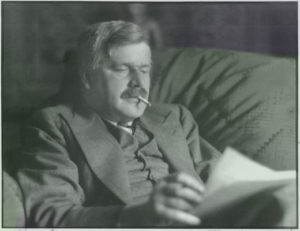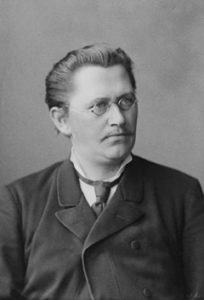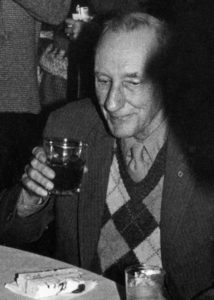At the time I took the apomorphine cure I had no claims to call myself a writer and my creativity was limited to filling a hypodermic. The entire body of work on which my current reputation is based was produced after the apomorphine treatment, and would never have been produced if I had not taken the cure and stayed off junk.
—William S. Burroughs
Like many non-medical professionals, my first exposure to the intriguing story of Dr. John Yerbury Dent and his “apomorphine cure” came via the legendary Beat writer, who struggled with heroin addiction for years. The Naked Lunch author became a tireless advocate for apomorphine after receiving it as treatment from Dr. Dent in London in 1956.
Burroughs described apomorphine—a non-narcotic morphine derivative that does not bind to the brain’s opioid receptors—as a “metabolic regulator.” Within a matter of weeks, he claimed, it not only weaned him off of heroin, but also completely rewired his brain to such an extent that he no longer desired it. For the rest of his life, Burroughs remained convinced that apomorphine had the potential to revolutionize addiction treatment.
Despite Burroughs’ cheerleading, Dent’s treatment never caught on. Prior to apomorphine’s re-emergence as a treatment for a very different condition in the late 1980s (thanks mostly to the work of British neuroscientist Andrew Lees, more on him later), the medical establishment tended to regard apomorphine as something between a curiosity and a quack-cure with niche literary mystique.
This article makes no claim about apomorphine’s potential efficacy, or lack of it, for addiction. A number of experts on methadone and other treatments that I contacted declined to comment, saying they didn’t know enough about it. (Although over the years a number of independent practitioners have used it.)
Instead, I want to get at the intriguing story behind apomorphine—one that’s relevant to how we approach potential new treatments today.
To do this, we need to hear more about the man who introduced Burroughs to the drug—a figure every bit as fascinating and controversial as the writer with whose name his is forever linked.
Dr. John Yerbury Dent
“He was an intellectual,” Warwick Sweeney, a London-based author and photographer—who also happens to be Dent’s grandson—told me. “Moved easily among the best minds of his generation … but very modest, too. Dent also lived a fairly bohemian life and enjoyed what might euphemistically be called an ‘open marriage.’”

Dr. Dent. Photo via ApomorphinevsAddiction.
Sweeney is the author of The Hardy Tree, a book about his grandfather’s life and work (Bracketpress, 2019.) Although Dr. Dent’s passing in 1962 meant that Sweeney never knew his grandfather personally, he seems to have inherited his fearsome intellect and anti-establishment leanings. He has maintained a website dedicated to telling the story of Dent’s work and, more importantly, exposing what he sees as a concerted effort to block further research into apomorphine’s potential for addiction.
The theme of the medical establishment/Big Pharma as blinkered gatekeepers comes up again and again.
“If we do not understand the past, we’ll only repeat it,” said Sweeney. “And sadly, tragically, unforgivably, successive British governments have caved in to corporations who have profited from the War on Drugs.”
The theme of the medical establishment/Big Pharma as blinkered gatekeepers—determined to scupper all research into a potentially valuable addiction treatment that might hurt profits—comes up again and again in this story. “Pharmaceutical researchers are told what to pursue by vested interest, which gives orders to the American Narcotics Department,” wrote Burroughs in his 1969 book, The Job. “Remember, these pharmaceutical companies have a vested interest in illness. Drugs that strike at the very root of illness are dangerous.”
Apomorphine was first synthesized in 1845 by boiling morphine in hydrochloric acid, and has a complex medical history. Originally used as an emetic (i.e., to induce vomiting) the possibilities of apomorphine as a behavioral inhibitor were first explored by pharmacologist Erich Harnack, an ethnic German born in Estonia, whose groundbreaking research in the late 19th century led to apomorphine’s first association with the treatment of alcohol dependence.
Harnack’s approach was blunt: The vomit-inducing effects of the drug were used to create a Pavlovian aversion to booze. (It was this unpleasant property that led to apomorphine’s later inclusion in the “secret formula” administered to patients undergoing the now-discredited, “Keeley Cure” across the US and Europe.)

Erich Harnack. Photo via Wikimedia Commons.
It was on the back of Harnack’s work that the young Dr. Dent, working with the destitute dependent drinkers who wound up in his ward at North London’s St. Pancras Hospital, first started administering apomorphine in the 1920s.
Back then, the very idea of “treating alcoholism” was a novel one. For Dent’s colleagues, standard procedure consisted of little more than pumping drunken patients’ stomachs before turfing them back onto the streets.
“I know of no medical textbook that includes advice on the treatment of acute misery or grief, no drugs are prescribed for broken hearts.”
Dent, however, pitied them and longed to do more. “Dent was always non-judgmental, which was surely part of his Quaker sensibility,” said Sweeney. “He was known as a ‘friend to drunks,’ when most doctors referred their drunks to the police.”
Or, as Dent himself put it in his 1937 book, The Human Machine: “I know of no medical textbook that includes advice on the treatment of acute misery or grief, no drugs are prescribed for broken hearts, and Dutch courage is all that is advised for terror.”
Looking for a way to break the despair, Dent began experimenting with apomorphine, and found that when he gave it to his alcohol-dependent patients, it seemed to help. In 1934, he presented his work to the Society for the Study of Addiction, theorizing that Pavlovian conditioning (that vomiting again) was behind its success.
Yet he soon changed his mind. Administered correctly—how he defined this is unclear, but he experimented a lot, including with high doses—the drug seemed to have a far more profound effect than simply creating a vomit-fueled aversion to booze. It seemed also to reduce craving and to help the person through the worst of the withdrawals.
“Empiricism further led Dent to reconsider his first conclusions, and to suspect that apomorphine acted through a deeper effect, related to the ‘hindbrain,’ and the suppression of craving—with no recourse to aversion,” wrote Manon Auffret and Marc Verin in a 2019 article for the American Academy of Neurology. “From there, Dent continuously battled to correct his “unfortunate” first statement (1949) and to broaden the use of apomorphine—even appealing to the American Medical Association for research.”
Dent would spend the rest of his professional life promoting apomorphine as a tool to fight addiction, later including heroin, while treating over a thousand people with the drug.
But his anti-theist bent and open dislike of the stuffy, conservative medical establishment of the day, according to Sweeney, helped to ensure that he remained something of a fringe figure. Sweeney also feels that a big part of the establishment’s mistrust of Dent and apomorphine was down to a simple lack of understanding.
“Like everyone else, the doctors and the neuropsychopharmacologists had been looking merely at the bio-chemical or material benefits of apomorphine,” Sweeney said. “Do not get me wrong; this needs to be properly understood. But neuroscience has separated it from every other dimension of what makes a human organism. This dimension of my grandfather needs to be properly understood, because it is complex and profound—but it is also fundamental to why he was successful with his patients but utterly useless with the politicians, and those he needed to convince to fashion policy… Like the arse-licking Anslingers, for example.”
Early Drug War Opponent; Apomorphine’s Demise
Dent’s distaste for Harry J. Anslinger, America’s first drug warrior, is documented in a series of letters he wrote opposing the creeping influence of US prohibitionist policies upon the British approach.
The “British System,” which allowed doctors to prescribe heroin and cocaine to people who were dependent, was eventually replaced by the Misuse of Drugs Act in 1971. Dent had warned that such a change would lead to a ballooning of the illicit market and an uptick in addiction.
“I fear we may turn London into a second New York.”
“If instead of the US following our very efficient methods of controlling heroin addiction and traffic, we are cowardly enough to copy their admittedly inefficient methods,” Dent wrote in one 1954 letter to Medical World, “I fear we may turn London into a second New York [referencing then-higher rates of drug addiction in New York].” History proved him right.
By the 1950s Dent was working in private practice, and it was in this capacity in the spring of 1956 that William S. Burroughs came into his orbit. In the years following his treatment, Burroughs became not only one of the best known (and most controversial) authors in the world, with the publication of his groundbreaking 1959 anti-novel Naked Lunch, but also a vocal advocate for apomorphine as a treatment for heroin addiction.
Despite the fact that Burroughs later relapsed a number of times, his opinion of the effectiveness of apomorphine never wavered. Indeed, he described his treatment under Dent with the zeal of the newly converted in “Deposition: Testimony Concerning A Sickness,” his preface to the Grove Press edition of Naked Lunch.
“The apomorphine cure is qualitatively different from all other methods of cure,” he wrote. “I have tried them all […] I can say definitively that I was never metabolically cured until I took the apomorphine cure. […] I suggest that research with variations of apomorphine and synthesis of it will open a new medical frontier extending far beyond the problem of addiction.” In Burroughs’ opinion, apomorphine was nothing less than a vaccine with the potential to eliminate addiction.
“Apomorphine was touted as a ‘silver bullet cure.’ It was not–and Dent never said that it was or that it could be.”
Sweeney implies that Burroughs did the cause no favors with such overstatement. “Apomorphine was touted as a ‘silver bullet cure’,” he explained. “It was not—and Dent never said that it was or that it could be.”
Still, Sweeney appreciates the author’s loyalty. “Burroughs was a radical, but a gent too. He never let Dent down and was consistent in his admiration … always.”

Burroughs in 1983. Photo via Wikimedia Commons.
Burroughs became an increasingly solitary advocate. As methadone, and later buprenorphine—both proven to greatly reduce mortality—came to dominate the opioid addiction medication field, there seemed to be no place for apomorphine.
The idea of using the drug for this purpose all-but died with Dr. Dent, in 1962. Although just a few years later, in 1965 and ‘67, studies in the Netherlands tantalizingly demonstrated apomorphine’s ability to increase dopamine-related activity in the brain.
Failure to investigate is resonant in an era where research into potential tools like ibogaine and MDMA has too often been blocked.
Ineffective advocacy may have played a role in the lack of further research into apomorphine for addiction. The harsh truth should also be noted—and I say this as a former methadone patient, who benefited greatly from it—that there is far more money to be made in treating people with drugs over a long period than there would be in an effective short-term treatment.
“’Maintenance’ was an anathema to Dent when abstinence was possible, but apomorphine had a bad rep,” said Sweeney. “[Prior to Dent] it was used as an aversion therapy, and aversion did not work. Dent knew this and adapted different protocols. He was a holistic practitioner. People who maintain that apomorphine doesn’t work have no idea how it is used.”
Again, I make no comment on whether or not apomorphine might work. But the failure of the scientific, medical and political establishment to fully investigate the possibility is resonant in an era where research into potential addiction tools like ibogaine and MDMA has too often been blocked.
An Uplifting Second Act
An uplifting postscript to the apomorphine story began in the 1970s, when Andrew Lees—professor of Neurology at London’s National Hospital for Neurology and University College London, and an admirer of Burroughs—found himself drawn to the story of apomorphine and began experimenting with it.
His research would eventually result in apomorphine’s rebirth as a commercial treatment (Apokyn) for Parkinson’s disease. This is a compelling story in its own right, brilliantly documented in Lees’ memoir, Mentored by a Madman: The William Burroughs Experiment (Psychedelic Press, 2017).
“Drugs like apomorphine should be reinvestigated as an alternative to buprenorphine and methadone in heroin addiction.”
Lees himself, whose research led to apomorphine’s glorious second act, has repeatedly expressed his frustration at the apparent lack of interest in researching apomorphine as a potential addiction treatment.
“Drugs like apomorphine should be reinvestigated as an alternative to buprenorphine and methadone in heroin addiction,” he told the Guardian in 2014. “There’s an urgent need for fresh trials in the use of apomorphine for dealing with addiction, but we are up against punitive and draconian legislation.”
I asked Sweeney if he thinks there is any possibility of apomorphine eventually coming out of the shadows for his grandfather’s intended purpose—or at least being rigorously researched.
“It could only happen if people cooperate—agencies, doctors, psychotherapists, governments and neuropharmacologists, with a unity of purpose,” he said. “It’s a conversation that desperately needs to happen.”
Detail of a poster for the 1991 David Cronenberg film Naked Lunch via Wikimedia Commons.





Show Comments